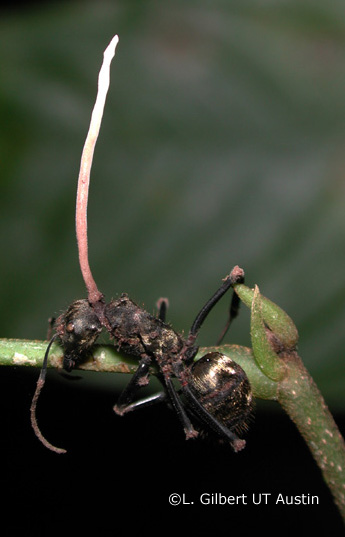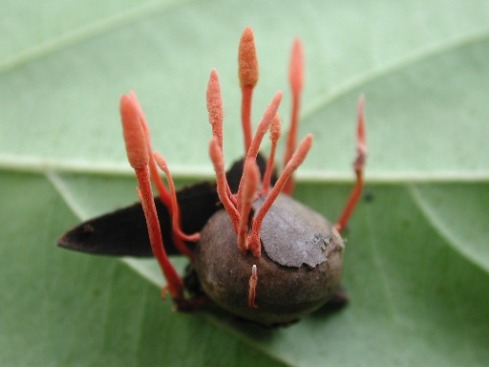The carpenter ant in the picture on the right (genus Campanotus), and the bullet ant in the first film clip below (Paraponera clavata), have fallen victim to parasitic fungi of the genus Cordyceps, which manipulate the behaviour of their host in order to increase their own chances of reproducing.

The spores of the fungus attach themselves to the external surface of the ant, where they germinate. They then enter the ant’s body through the tracheae (the tubes through which insects breathe), via holes in the exoskeleton called spiracles. Fine fungal filaments called mycelia then start to grow inside the ant’s body cavity, absorbing the host’s soft tissues but avoiding its vital organs.
When the fungus is ready to sporulate, the mycelia grow into the ant’s brain. The fungus then produces chemicals which act on the host’s brain and alter its perception of pheromones. This causes the ant to climb a plant and, upon reaching the top, to clamp its mandibles around a leaf or leaf stem, thus securing it firmly to what will be its final resting place.
The fungus then devours the ant’s brain, killing the host. The fruiting bodies of the fungus sprout from the ant’s head, through gaps in the joints of the exoskeleton. Once mature, the fruiting bodies burst, releasing clusters of capsules into the air. These in turn explode on their descent, spreading airborne spores over the surrounding area. These spores then infect other ants,completing the life cycle of the fungus. Depending on the type of fungus and the number of infecting spores, death of an infected insect takes between 4-10 days.
The carpenter ant in the photograph has been infected by Cordyceps unilateralis, which is but one of thousands of species of entomopathogenic fungi, more than 400 of which belong to the Cordyceps genus. Between them, these parasitic fungi infect at least nine different orders of arthropods, including the Odonata (dragonflies and damselflies), Blattaria (cockroaches), Hemiptera(aphids, cicadas and leafhoppers), Coleoptera (beetles), Phasmida (stick insects), Hymenoptera (ants, bees and wasps), and Lepidoptera (butterflies and moths). The host range of an individual species is, however, restricted to one species or to a small number of closely related species.
Because they are considered as environmentally safe, natural mortality agents, entomopathogenic fungi are used as biological pesticides to control pest species. For example, Metarhizium anisopliae was first used over 100 years ago to try and control the wheat grain beetle Anisoplia austriaca. More recently, researchers have investigated the use of Metarhizium anisopliae, a species which infects the African mosquito Anopheles gambiae, to control the spread of malaria.
Entomopathogenic fungi are not the only parasites that can modify the behaviour of their hosts. Equally remarkable is the nematomorph hairwormSpinochordodes tellinii, which is also known as the horsehair worm or the gordian worm, because of its resemblance to the knot created by the Phrygian king Gorius. (According to myth, Gordius used his knot to tie a chariot to a pole, and declared that whoever could untie it would rule all of Asia.)
The juvenile gordian worm parasitizes land-living arthropods such as grasshopers, locusts and beetles, but the adult is a free-living aquatic species which can only reproduce in water. Inside the host, the microscopic larvae feed on surrounding tissue, and develop into long worms which can reach up to 4 times the length of the host, and which remain within the body cavity of the host as a long, coiled mass. After metamorphosing, the adult worm induces its host to leave its terrestrial habitat, and to commit suicide by jumping into water and drowning itself, so that the worm can emerge:
David Biron and his colleagues have used proteomics to characterise the proteins synthesized by the gordian worm in order to determine how it manipulates its host’s behaviour. They have established that the worm synthesizes proteins which mimic those produced by the insect. These include proteins of the Wnt family, which are involved in the development of the nervous system, as well as others which interfere with the neurotransmitter systems involved in the host’s geotactic behaviour (its oriented movements in relation to the Earth’s magnetic field).
Because the genes encoding these proteins are contained in the worm’s genome, but have a direct effect on the insect’s central nervous system when they are expressed, the relationship between the gordian worm and its host is an example of what Richard Dawkins called the extended phenotype, whereby genes expressed by one organism have an effect on the appearance or behaviour of another. (Entomopathogenic fungi and their hosts are also an example of an extended phenotype.)
Incredibly, the gordian worm can survive predation on its host. Parasites use various strategies to survive host predation. For example, some develop quickly, in order to emerge from the host before it is preyed upon. Grasshoppers and crickets are preyed upon by fish and frogs; the gordian worm can escape this predation by wriggling out of the mouth, nose or gills of the predator once it has emerged from a host that has been eaten:

omfg!
ReplyDeleteawsomeee!!
holy shit awesome but it kinda pissed me off because I currently have an ant problem. lol
ReplyDeletepoor ants
ReplyDeleteHuh, fascinating!
ReplyDeletecongrats on the successful blog... you have a good thing going here
ReplyDeleteNow I am even more afraid of nature... worms are gona get all up in my brains and make me drown myself!
ReplyDeletelol that's so cool...well you know what i mean
ReplyDeletei will be back to read this. as i have too much hw to do to read all that. but i love reading about insects.
ReplyDeletereminds me how my house has all these ants right now, feels bad man...
ReplyDeletep.s. when are u gonna post a video of yourself?!?!
Tons of parasites in the insect world. google Zombie Snails for more.
ReplyDeleteThats just NUTS!
ReplyDelete